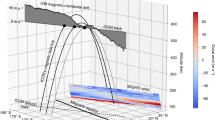Abstract
SEVERAL authors have demonstrated that, at very high latitudes, the critical frequency and height of the ionospheric F2 layer are strongly dependent on Universal Time. For example, Duncan1 has shown that, in winter, a maximum occurs in the F2 layer critical frequency (f0F2) near 0600 UT for Antarctic stations close to the magnetic pole. Piggott and Shapley2 have confirmed this and demonstrated a similar behaviour in the height of maximum electron density (hmF2). Duncan has suggested that the daily transport of the eccentric geomagnetic field through the interplanetary plasma could cause a tide in the geomagnetic field, which in turn would cause dumping of charged particles into the polar ionosphere. Hill3 has proposed that the phenomenon, being sporadic, is caused by electromagnetic drifts associated with polar-cap events. In contrast, Wilkes4 has pointed out that a global standing wave could explain the observed UT control of the polar tropospheric pressure; such an oscillation could also affect the atmosphere at ionospheric heights. Recently, King et al.5 have suggested that the phenomenon could be explained by vertical drifts in ionization, caused by atmospheric winds in the F layer.
This is a preview of subscription content, access via your institution
Access options
Subscribe to this journal
Receive 51 print issues and online access
$199.00 per year
only $3.90 per issue
Buy this article
- Purchase on Springer Link
- Instant access to full article PDF
Prices may be subject to local taxes which are calculated during checkout
Similar content being viewed by others
References
Duncan, R. A., J. Geophys. Res., 67, 1823 (1962).
Piggott, W. R., and Shapley, A. H., Antarctic Res., Geophys. Monogr. No. 7, 111 (1962).
Hill, G. E., J. Atmos. Sci., 20, 492 (1963).
Wilkes, M. V., Oscillations of the Earth's Atmosphere, 11 (Cambridge Univ. Press, 1949).
King, J. W., Kohl, H., Preece, D. M., and Seabrook, C., J. Atmos. Terr. Phys., 30, 11 (1968).
Challinor, R. A., Planet. Space Sci., 16, 557 (1968).
Challinor, R. A., Planet. Space Sci. (in the press).
Geisler, J. E., J. Atmos. Terr. Phys., 29, 1469 (1967).
Kohl, H., and King, J. W., J. Atmos. Terr. Phys., 29, 1045 (1967).
Author information
Authors and Affiliations
Rights and permissions
About this article
Cite this article
CHALLINOR, R. Universal Time Control of the Polar Ionosphere. Nature 221, 941–943 (1969). https://doi.org/10.1038/221941b0
Received:
Issue Date:
DOI: https://doi.org/10.1038/221941b0
This article is cited by
-
Universal Time Control of the Antarctic Ionosphere
Nature Physical Science (1971)
Comments
By submitting a comment you agree to abide by our Terms and Community Guidelines. If you find something abusive or that does not comply with our terms or guidelines please flag it as inappropriate.



